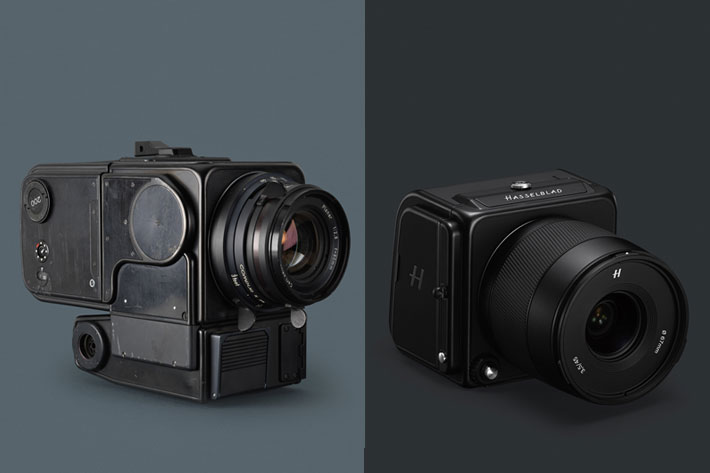
The limited 907X Special Edition with which Hasselblad celebrates the company’s role in the historic Apollo 11 moon landing has a special commemorative anniversary text: “On the Moon Since 1969”.
Hasselblad proudly celebrates being the camera that documented the historic Moon landing with the introduction of the 907X Special Edition. The limited-edition kit includes the 907X camera body and CFV II 50C digital back, both in matte black. Reminiscent of the classic V System film magazine design, the modern CFV II 50C also works as a stand-alone digital back. Compatible with most V System cameras made from 1957 and onwards, the CFV II 50C can also be used on third party technical or view cameras.
Coupling the CFV II 50C with Hasselblad’s smallest medium format camera body ever, the 907X, creates a highly compact mirrorless digital camera. This combination offers a truly distinct photographic experience, including the classic waist-level shooting style of the V System enabled by the CFV II 50C’s tilt screen. With the 907X attached to the CFV II 50C, the photographer gains access to all the high-quality XCD Lenses, providing autofocus and electronic exposure control. Coupled with the XH Adapter, all HC/HCD Lenses can be used on the 907X, along with XPan and V System Lenses in electronic shutter mode with the XPan and XV Lens Adapters, respectively. In addition, the 907X enables compatibility with a wide range of third-party adapters and lenses in electronic shutter mode.
Two lenses used on the Moon
This model would be a dream for the astronauts, both for its size and weight and the ability to take hundreds of pictures on a single card, something that was not available then and limited the number of photos taken during the mission, especially on the Moon surface.
Taken down to the lunar surface, attached to astronaut Armstrong’s chest, was a silver Hasselblad Data Camera (HDC) fitted with a Zeiss Biogon 60mm ƒ/5.6 lens and 70mm film magazine which had never actually been tested in space before. A second black Hasselblad Electric Camera (HEC) with a Zeiss Planar 80mm ƒ/2.8 lens was used to shoot from inside the Eagle lunar module. A third black HEC was used by astronaut Michael Collins aboard the Command Module Columbia in lunar orbit.
Working perfectly under the extreme conditions of the lunar surface, the HDC produced some of history’s most iconic photographs. After the successful shooting on 21 July 1969, the Hasselblad was hoisted up to the lunar lander with a line. Securely removing the film magazines, both cameras with lenses were left behind on the Moon in order to meet narrow weight margins for successful return.
12 Hasselblad cameras on the Moon
The journeys home from the Moon made very special demands on what could return regarding weight; from Apollo 11 to the final Apollo 17 mission, a total of twelve camera bodies were left behind on the lunar surface. Only the film magazines containing the momentous images were brought back. The black HEC used by Collins inside the command module was taken back to Earth.
Hasselblad and NASA’s journey together began years before the Moon landing, in 1962 during the Mercury program. Prospective NASA astronaut and photography enthusiast Walter Schirra had his own Hasselblad 500C with a Planar f/2.8, 80mm lens. Knowing the high quality of the Hasselblad camera, Schirra suggested to NASA that they use a Hasselblad to document space since the previous camera model utilised delivered disappointing results.
After buying a few 500Cs, a weight-loss program followed including removal of its leather covering, auxiliary shutter, reflex mirror, and viewfinder. A new film magazine was constructed in order to allow for 70 exposures instead of the usual 12. Finally, a matte black outer paint job minimized reflections in the window of the orbiter. The streamlined Hasselblad would find itself in the payload for Mercury 8 (MA-8) in October 1962. The successful, high quality images that Schirra captured across his six orbits of the Earth would spark a new chapter in the history of Hasselblad and a long, close and mutually beneficial cooperation between the American space agency and the Swedish camera manufacturer. The photography manual used by the astronauts can be downloaded following the link on this page.
Limited edition is matte black as Collins camera
The limited-edition kit now announced comes in matte black, just as the HEC that made it back to Earth. On the digital back is the text “On the Moon Since 1969”, commemorating the HDC and HEC left behind on the lunar surface fifty years ago. Together, the 907X and CFV II 50C connect Hasselblad’s photographic history into one system.
Key features of the 907X Special Edition include:
- Large medium format 50MP CMOS sensor
- Up to 14 stops of dynamic range
- Captures 16-bit RAW images and full resolution JPEGs
- High-resolution 3.0-inch 920K dot touch and tilt screen
- Smooth live view experience with a high frame rate of 60fps
- Focus peaking, enabling more accurate focusing (especially advantageous on the manual-focused V System cameras)
- Intuitive user interface with swipe and pinch touch controls
- Internal battery slot with the option to recharge in-camera via the USB-C port (same battery used on the X System)
- Dual UHS-II SD card slots
- Integrated Wi-Fi and USB-C connection
- Portable workflow with Phocus Mobile 2 support
Continuing the celebration, Hasselblad releases a limited edition 50 Years on the Moon merchandise collection, including posters, t-shirts, patches and stickers that commemorate this historical anniversary. The whole collection is available for purchasing here.
The 907X Special Edition has an MSRP of € 6500 / $ 7499 / £ 5825 excl. VAT. Ordering information and availability will be announced later in the year.
